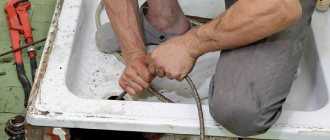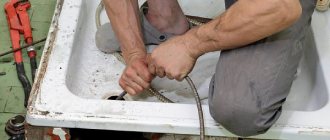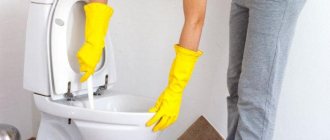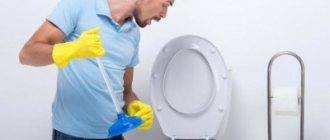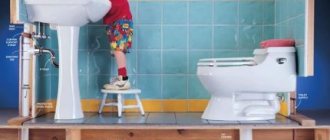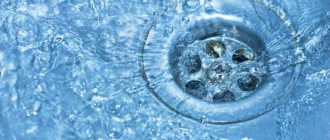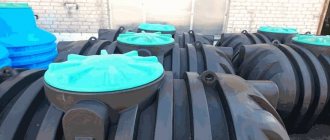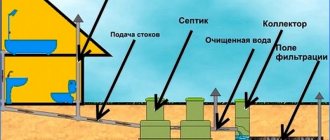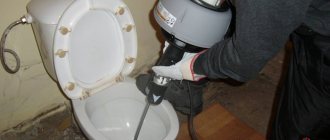Drainage, like all plumbing systems, can have problems. Often, sewer pipes become clogged, but you can clean the sewer in a private home without calling a specialist. Often there is no need to even buy special cleaning compounds - use what can be found in any home to remove plugs in pipes. The main thing is to find 1-2 hours of free time.
Causes of blockages
There are several causes of blockage; most often, blockages appear due to improper operation. First of all, you need to describe the reasons that the owner of the house cannot influence:
- Pipe material. Cast iron pipes are more likely to become clogged, the reason being the roughness inside the cast iron pipes. First, grease and dirt settle on the walls, after which the blockage grows like a snowball;
- Incorrect installation of sewerage. If pipes are laid with sharp turns, with an incorrect slope and erroneous calculations of hydrodynamic characteristics, blockages will most likely appear;
- Sewerage laid at insufficient depth freezes in cold weather, or may shift due to soil shifts.
Often, clogging occurs due to improper use. Scraps of rags, debris, food particles - these can quickly ruin the drainage system. To avoid having to clean your drains frequently, take care to keep these items out of the drain system.
Why should you contact customer service?
It is quite difficult to determine how high the level of sewer blockage is and which method to choose to clear it. Without understanding the scale of the problem, you can make a mistake in choosing the means to remove the blockage and only aggravate its consequences. Experienced craftsmen from “Plumber Service” can guarantee a positive result in the fight against blockages.
A professional plumber will quickly assess the scale of the disaster and select the best solution to solve the problem. Our technicians promptly respond to calls to flush the drains in a private home and save their clients’ time. All you need to do is leave a request by phone and wait for the plumbers to arrive. Our service department offers the most affordable prices for drain cleaning. Competent consultants will make a preliminary calculation of the service and answer all questions.
How to clean sewers in a private house with your own hands
Before deciding which method is most convenient to clean sewer pipes, you need to find where the blockage occurred. You will need to check the entire system, starting from the drain hole through which water does not flow out. Most often, blockages appear:
- On the sink drain;
- In the area between the bathroom and the kitchen;
- On the toilet flush;
- At the junction of the sewer riser and the toilet outlet.
All sewerage cleaning methods are divided into mechanical methods, chemical cleaning, thermal and hydrodynamic cleaning. The choice of method depends on the location of the blockage, the material of the sewer pipes and the severity of the blockage.
Plastic pipes are the least likely to become clogged, but if they are clogged, not all cleaning methods can be used. For example, certain types of plastic pipes cannot be cleaned using the thermal method. It is not advisable to pierce thin-walled products using a metal method; for such pipes it is better to use chemical compounds.
What causes blockages?
- Paper. Drainage often becomes clogged when magazine pages or newsprint get into the pipes. If there are a lot of them, a plug will appear blocking the path of the liquid;
Important! Dense cellulose, when soaked, increases in volume. If the water immediately drains away slowly, then after a short time, when the paper swells, the sewer pipe will be completely blocked.
- Food waste. The toilet can easily absorb sour borscht, while boiled potatoes or missing porridge form a strong clog;
- Rags. They usually get into the pipes after you pour water down the toilet after washing windows or floors. Even a small particle of a rag clings to the slightest burr in the pipe, dirt sticks to it and a barrier to water appears;
- Animal fur and human hair. They cling to any obstacles inside the pipes; in addition, they settle on the grates protecting the outlets of the bathtub and sinks;
- Construction garbage. It is collected in places with a slight slope and after a while completely blocks the pipe;
Important! The worst thing you can do is use the sewer to remove the remains of plaster and building compounds. Cement and lime adhere perfectly inside the pipe. Such a blockage can only be cleared by completely dismantling the sewer or replacing the toilet.
- Cat litter. Fillers that absorb a lot of moisture, used for pet litter boxes, are made on the basis of clay; this material adheres well to pipes and is able to block them tightly;
- But the main culprit behind blockages is fat that gets into the drain when washing dishes. It settles on the walls of the pipes, which leads to the fact that in 1-2 years the lumen of the pipe will be clogged.
Attention! You can determine why a pipe is clogged by asking family members what they were doing before the clog appeared. This does not apply to wool and fat - because of them, plugs appear gradually.
How to find the area where the blockage occurred
If water flows slowly from the toilet, bathtub or sink, you need to find not only why the pipes are clogged, but also where it happened.
| Symptoms | Where to look for a clogged pipe |
| Water does not drain well from the washbasin or bathroom, but there is no problem in other rooms. | You need to check the siphon of the sink or bathtub, check the corrugated pipe connecting the sewer pipe and the siphon. |
| Some plumbing fixtures do not work; water is removed from the toilet without problems. | The blockage is located near the comb. You need to look at the pipes in front of the tee to which the toilet is connected. A sagging comb indicates that dirt has accumulated in the lowest area. |
| Water does not drain from all plumbing outlets; when the neighbors drain above, the level rises. | The sewer pipe in the basement or riser is clogged. |
The first thing you need to pay attention to
In fact, a clogged sewer is the carelessness of the housewife. Whatever doesn't drain into the hole in the sink. But a little patience, a little responsibility, and a sewer blockage will never occur. To do this, you just need to clean off dirty plates with a napkin. Remove food debris, fat and oil from them.
But if suddenly the situation still shows that a blockage has occurred, then do not immediately call a plumber. Sometimes you can do without it. After all, the first thing after washing is the siphon, which is a water device that cuts off the water from the sewer. Its task is to prevent unpleasant odors from entering the room. Additionally, it collects some of the dirt, which is drained into the sewer system.
It just needs to be disassembled, cleaned and reinstalled. This will take 10 minutes. At the same time, disassembling the siphon is not difficult; any woman, not to mention men, can handle it. But if the siphon turns out to be clean after disassembly, then the problem is not in it, but in the pipe that is located behind it. And here everyone decides for themselves how to clean the sewer.
Disassembling the kitchen sink siphon Source avatars.mds.yandex.net
Mechanical sewer cleaning
Once the cause and location of the blockage have been found, you need to decide how to clean the pipes.
Pipe clogged with paper
The easiest way to remove a cork from paper is to use a water hammer. A significant increase in fluid pressure on one side will push the ball of paper through the bottleneck.
Important! This will not completely remove the plug, but will only move the clump into the riser. The paper usually becomes limp in the riser and does not cause any more problems. But sometimes it is possible to block the exit to the well or the bed. This nuisance is possible if the drain is clogged with grease, hair or other debris.
Water hammer can be created in several ways:
- With a plunger. Such a device covers the liquid in the area of discharge from the bathtub or sink. When you press the handle sharply, high pressure is created in the pipe;
- You can create a water hammer using a plastic bottle; you need to take a 1.5-2 liter container, screw the cap tightly and cut off the bottom. This device is used like a plunger;
- You can create a water hammer with a simple device made from a stick and a rag, which is folded in several layers. They place it on a surface of water at the point where the toilet flushes, and sharply press it with a stick. Don’t get carried away - too strong impacts can damage ceramic plumbing fixtures.
The last option can only be used when the toilet is clogged. A paper plug that has clogged a pipe cannot be pushed through in this way - when you press the device, the liquid will begin to flow into the bathtub or sink.
Food waste clog
It is better to clean such contamination of sewer pipes with a plumbing cable. Externally, it is an ordinary steel cable of small diameter; on one side of the cable there is a handle with which it can be rotated.
It is necessary to mention several important subtleties of using such a device:
- The cable must be inserted into the pipe under tension. If it weakens, it folds in half and forms a loop;
- It is most convenient to work with a partner; one person stretches the cable and rotates the handle, and the second person pushes it into the pipe;
- The cable should pierce the blockage several times;
- Remaining debris is removed by pouring a lot of water into the pipe.
Video description
The video shows how a home handyman uses a plumbing cable to clean the drains in a house:
Attention! Keep in mind that the cable does not pass through 90° elbows. Therefore, use the revisions as places through which you can push the device.
And a few words about the types of plumbing cable. They are presented on the market in two types: a regular cable woven from a large amount of steel wire, and in the form of a spring, that is, a twisted version.
The assortment is also rich in terms of sizes. This applies to both length and diameter. Plus, today plumbing cables are equipped with different attachments. Eg:
- spiral - it is screwed into the cork and can simply be pulled out;
- ball - they are often used to push the blockage further along the pipe towards the riser, where the plug will fall into a pipe with a large diameter;
- crown - it cuts the plug.
And one moment. Today, plumbers use special cables that can be used alone. The cable is wound on a drum, to which an electrical device in the form of a drill is connected. That is, you can push it into the pipe with one hand, and with the other you can press the handle button, which sets the cable into rotation.
Types of nozzles for plumbing cable Source 123ru.market
Chemical sewer cleaning
Organic blockages can be removed not only mechanically, but also using chemical compounds. It is important to remove the water in front of the plug; a higher concentration of the drug increases its effectiveness.
A common product for cleaning sewer pipes is Mole. This is sodium hypochlorite dissolved in water. It is poured into the clogged pipe and left for 4-8 hours, then the drain is washed with water.
If there is no Mole, then you can remove the blockage with alkali or acid. The chemical composition of Mole is similar to the bleach Belizna. But other substances can also be used:
- Electrolyte;
- Caustic soda;
- Vinegar;
- Lemon acid;
- Cleaning preparations (for example, Sillit or Dometos);
- Oxalic acid.
A sewer system clogged with a rag can be cleaned with a plumbing cable, but only indoors. If the ladder or the main riser, where the cable folds into loops, is clogged, use stiff wire.
Prohibitions when cleaning
When cleaning the drain system, the following restrictions must be observed:
- You should not try to break through the blockage using chemicals that are not intended for this purpose. As a result, the drainage system may be damaged.
- Do not use household chemicals that are not intended for a specific type of pipe. Information about this can be read on the packaging.
- Do not start cleaning without personal protective equipment.
- Do not mix several clog clearing products at once. When combined together, they can release very caustic fumes and even damage communications.
Cleaning drains with wire
To clean the sewer system, you need a wire 5-6 mm in diameter. It is used in the same way as a cable, there are only 3 differences:
- The wire bends poorly and has difficulty penetrating pipe bends. If there is no tee or inspection, then you will have to disassemble the connection or, as a last resort, punch a temporary hole in the pipe. When the pipe is clean, cover the hole with a cut inner tube from a bicycle or a rubber bandage. A clamp is installed on top of this winding;
- The blockage must be cleared from top to bottom, otherwise several meters of accumulated wastewater will immediately pour out on you;
- You need to rotate the wire when removing it, so the hooked rag will not come off.
Human hair and animal hair are removed from the pipe using wire or cable. Hair is removed from under the outlet grill in 2 ways:
- Hooking them with a wire hook;
- Disassemble and clean the grille.
Cat litter or construction waste is removed using a wire brush or cable.
Sewer flushing
Sewer pipes clogged with grease can only be cleaned by rinsing them with hot water.
- If there is no gap at all in the fat layer, the cork is first pierced with wire or cable;
- Connect the flushing hose with hot water;
- Insert its tee or revision above the clogged area;
- Hot water is released into the pipe, gradually increasing the pressure.
If fat has frozen in a pipe in an apartment, you can simply run hot water into it, gradually increasing the flow until the fat plug warms up. Water heated to 80 degrees removes fat plugs in 30-60 minutes.
Layering of salt and fat deposits
A narrowing of the passage inside the pipes can occur due to the layering of deposits from various types of waste of inorganic and organic origin on their walls, and then you need to immediately decide how to flush the sewer pipes.
A thick coating inside the drain structure may appear as a result of the settling and adhesion of fat particles on its inner surface. One of the common causes of blockages in pipes is the use of hard water in household activities, which collects salt deposits much faster. Metal pipelines especially suffer from this.
Remedy for sewer blockages
If simple methods are powerless, you will have to use special chemical compounds, they come in 3 types:
- Liquid;
- Gel-like;
- Powder.
Any product differs from others, in addition to consistency, in its effect on blockages, pipe material, and human health.
There are many different detergent and cleaning compositions on the market, including both good products and ineffective ones. Below is a list of products intended for cleaning sewer pipes.
| Powder products | ||
| 1 | Chirton "Clean drains" | Inexpensive but high quality composition |
| 2 | BAGI Pothan | Fast-acting drug |
| 3 | ORO-fix | Removes odors well |
| Liquid products | ||
| 4 | Mole | Inexpensive but effective remedy |
| 5 | YPLON Drain Cleaner | Reliable drug |
| 6 | Mister Dez | Low cost |
| Gel-like compositions | ||
| 7 | Sanfor (0.75 l) | Quickly clears clogs (about 5 minutes) |
| 8 | TIRET (1 l) | Effective drug |
| 9 | Deboucher Active (1 l) | Effective drug |
OUR ADVANTAGES
| We carry out work of any complexity | Nice prices below market prices and discounts for large customers | Efficiency of work execution, quick on-site visits |
| Pleasant service and individual approach | We have tele-inspection equipment that allows you to identify blockages and choose the best flushing methods to achieve the best results. | All our employees are highly qualified experienced professionals |
| An official contract is concluded that guarantees the work | Payment is made only after the work is completed | We work not only in Mosev, but also in the region |
Preventing blockages
To ensure that the sewer system does not cause you problems, you need to follow a few simple rules. Make sure all drains have screens to filter out contaminants from the water. Do not throw rags, food waste or grease-containing waste down the drain. It's better to use a trash can. When cleaning, pour boiling water over the drain holes. Flush the drains at least twice a year with chemical compounds to prevent blockages.
Follow the rules:
- The toilet is designed for one purpose only. Use a trash can to dispose of leftover food and various debris;
- When pouring out water after cleaning the apartment, check whether you left a rag in the bucket;
- There must be nets on the drain holes of bathtubs and sinks;
- Wash dishes only with hot water; statistics show that the maximum number of local blockages occurs in the summer, after the temperature of the water in the hot water supply decreases to 40-45 degrees.
